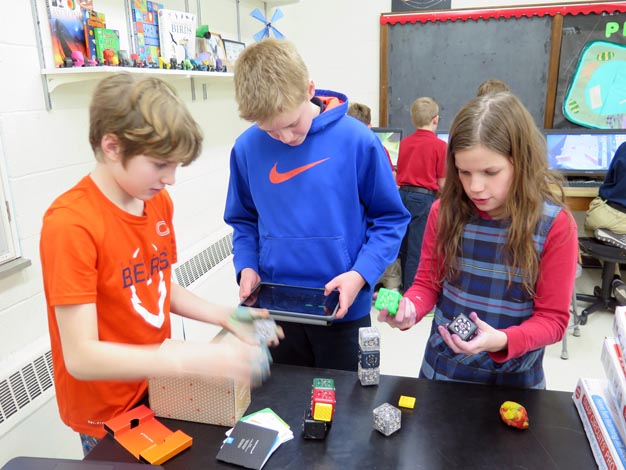
From left, students Odin Moore, Owen Herrman and Inara Wiegand work on a STEM project at All Saints Catholic School in Davenport earlier this school year.
By Anne Marie Amacher
The Catholic Messenger
DAVENPORT — Sparking an interest in STEM education and allowing students to explore different fields prompted All Saints Catholic School to form two clubs, now in their second year. STEM stands for science, technology, engineering and mathematics. The STEM club is currently suspended since school buildings are currently closed due to the coronavirus pandemic.
STEM for grades 5-8
“Having the base knowledge can allow students to want to explore these fields further and maybe someday hold a career in STEM,” said Adam Tucker, middle school science teacher and advisor for the grades 5-8 STEM club. “Many students also do not have access to many of the materials and opportunities that we provide in the classroom, so this allows them to really indulge in a way that would not be possible without our club.”
Last year Tucker averaged 10-15 students for weekly meetings. “This year we averaged anywhere from 20-30 students weekly.”
STEM challenges students to explore engineering design processes and students’ abilities to think about and work through problems, Tucker said. They also learn by making mistakes and reviewing and modifying designs based on failed tests. Examples of STEM activities for the middle-school students included programming, circuit work, robots, new technology and software, stop-motion animation, video game design, chemical reactions, biology (using microscopes and analyzing specimens) and mini STEM challenges students can complete in several minutes.
Many students enjoyed working through Zspace lessons, he said. Zspace “combines elements of augmented reality and virtual reality to create lifelike experiences (youthtechnologynetwork. com/zspace). This is one of their favorite applications in the classroom. This provides a real-world experience through technology and the use of 3D imaging and augmented reality.” All Saints received an Innovative Project in Technology award earlier this year for its Zspace lab.
This semester Tucker set up a paludarium, “an enclosed and at least partially, transparent container housing plants and sometimes animals. It consists of both a water and land area.” Students took care of a veiled chameleon. “This is more than just a class pet. Students are in charge of monitoring humidity levels using our digital hygrometers and gradient temperature levels. Students learn about how energy and nutrients are transferred through a food chain, providing food sources that are enriched or fortified given the chameleon’s dietary needs.”
Zelda, the chameleon, is currently with Tucker at his home.
More schools now implement STEAM, adding arts to the mix. “I have recently also been incorporating a lot of art-related options for our students,” Tucker said before the closing on in-person classes. A lot of science can be taught and learned through these experiences, he added.
Typically, each STEM meeting began with a lecture and examples. “If there’s science to be shared that benefits the students’ understanding, then it is a viable component to each meeting.” However, many times students receive minimal instruction and figure out processes and solutions through a trial and error process. “This is also a great way for them to learn not only how to succeed, but how to fail and keep working at it,” he said.
Fifth-grader Brenden Wiley enjoyed STEM club a lot and especially enjoyed using the Zspace lab. The 3-D effect “makes it so real,” he said.
Fourth-grader Cooper Briggs-Spies received permission to join the upper-grade STEM program. He worked on a stop-motion project using clay characters and a computer tablet. His first attempt to make a movie went well until he lost the pieces to finish the project. Since it was December, he decided to do a new project inspired by the Elf on the Shelf character. “He’s inspiring, yet creepy,” Cooper said of the elf.
STEM for grades 3-4
Katti Parker is a first-grade teacher but volunteered to be advisor for the grades 3-4 STEM club. Twenty-five students are in the club, with a waiting list of at least 10 students.
Each week featured a different project. Sometimes students worked as individuals, other times in pairs or larger groups.
For their project in December, each group of two had to design an igloo. Groups received a sheet on which to draw an igloo design and had to provide a “want list” of how many small and large marshmallows and toothpicks they would need to complete the project, Parker said.
After they received their materials, students built their igloos. Parker asked the students what materials would be required to for a real igloo. Would it have an entrance? How would someone keep warm? What is the shape? Students gave answers and then examined their igloos. All realized their igloos were open and would let in cold air.
Parker asked students to add up the cost of the small and large marshmallows and toothpicks and to decide whether they would have built their igloos in a different way. She had the students draw an image of their final product to compare with their original design and asked why it changed.
Students Isabell DeVries and Lillian Nguyen worked as a team and thought the project was fun. Isabell said it would be fun to build a candy igloo.
Lillian said it would be fun to use different materials as well.











